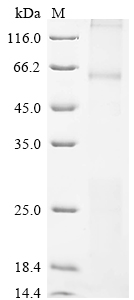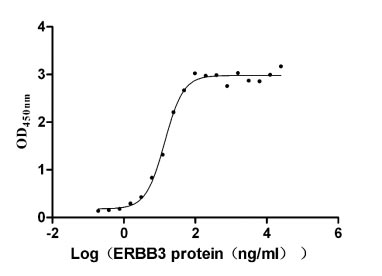Recombinant Human Mucolipin-1 (MCOLN1)
In Stock-
货号:CSB-CF872417HU
-
规格:¥9720
-
图片:
-
其他:
产品详情
-
纯度:Greater than 85% as determined by SDS-PAGE.
-
基因名:MCOLN1
-
Uniprot No.:
-
种属:Homo sapiens (Human)
-
蛋白长度:Full Length
-
来源:in vitro E.coli expression system
-
分子量:66.5 kDa
-
表达区域:1-580aa
-
氨基酸序列MTAPAGPRGSETERLLTPNPGYGTQAGPSPAPPTPPEEEDLRRRLKYFFMSPCDKFRAKGRKPCKLMLQVVKILVVTVQLILFGLSNQLAVTFREENTIAFRHLFLLGYSDGADDTFAAYTREQLYQAIFHAVDQYLALPDVSLGRYAYVRGGGDPWTNGSGLALCQRYYHRGHVDPANDTFDIDPMVVTDCIQVDPPERPPPPPSDDLTLLESSSSYKNLTLKFHKLVNVTIHFRLKTINLQSLINNEIPDCYTFSVLITFDNKAHSGRIPISLETQAHIQECKHPSVFQHGDNSFRLLFDVVVILTCSLSFLLCARSLLRGFLLQNEFVGFMWRQRGRVISLWERLEFVNGWYILLVTSDVLTISGTIMKIGIEAKNLASYDVCSILLGTSTLLVWVGVIRYLTFFHNYNILIATLRVALPSVMRFCCCVAVIYLGYCFCGWIVLGPYHVKFRSLSMVSECLFSLINGDDMFVTFAAMQAQQGRSSLVWLFSQLYLYSFISLFIYMVLSLFIALITGAYDTIKHPGGAGAEESELQAYIAQCQDSPTSGKFRRGSGSACSLLCCCGRDPSEEHSLLVN
Note: The complete sequence including tag sequence, target protein sequence and linker sequence could be provided upon request. -
蛋白标签:N-terminal 10xHis-tagged
-
产品提供形式:Liquid or Lyophilized powder
Note: We will preferentially ship the format that we have in stock, however, if you have any special requirement for the format, please remark your requirement when placing the order, we will prepare according to your demand. -
缓冲液:If the delivery form is liquid, the default storage buffer is Tris/PBS-based buffer, 5%-50% glycerol. If the delivery form is lyophilized powder, the buffer before lyophilization is Tris/PBS-based buffer, 6% Trehalose.
-
复溶:We recommend that this vial be briefly centrifuged prior to opening to bring the contents to the bottom. Please reconstitute protein in deionized sterile water to a concentration of 0.1-1.0 mg/mL.We recommend to add 5-50% of glycerol (final concentration) and aliquot for long-term storage at -20℃/-80℃. Our default final concentration of glycerol is 50%. Customers could use it as reference.
-
储存条件:Store at -20°C/-80°C upon receipt, aliquoting is necessary for mutiple use. Avoid repeated freeze-thaw cycles.
-
保质期:The shelf life is related to many factors, storage state, buffer ingredients, storage temperature and the stability of the protein itself.
Generally, the shelf life of liquid form is 6 months at -20°C/-80°C. The shelf life of lyophilized form is 12 months at -20°C/-80°C. -
货期:3-7 business days
-
注意事项:Repeated freezing and thawing is not recommended. Store working aliquots at 4°C for up to one week.
-
Datasheet & COA:Please contact us to get it.
相关产品
靶点详情
-
功能:Nonselective cation channel probably playing a role in the regulation of membrane trafficking events and of metal homeostasis. Proposed to play a major role in Ca(2+) release from late endosome and lysosome vesicles to the cytoplasm, which is important for many lysosome-dependent cellular events, including the fusion and trafficking of these organelles, exocytosis and autophagy. Required for efficient uptake of large particles in macrophages in which Ca(2+) release from the lysosomes triggers lysosomal exocytosis. May also play a role in phagosome-lysosome fusion. Involved in lactosylceramide trafficking indicative for a role in the regulation of late endocytic membrane fusion/fission events. By mediating lysosomal Ca(2+) release is involved in regulation of mTORC1 signaling and in mTOR/TFEB-dependent lysosomal adaptation to environmental cues such as nutrient levels. Seems to act as lysosomal active oxygen species (ROS) sensor involved in ROS-induced TFEB activation and autophagy. Functions as a Fe(2+) permeable channel in late endosomes and lysosomes. Proposed to play a role in zinc homeostasis probably implicating its association with TMEM163 In adaptive immunity, TRPML2 and TRPML1 may play redundant roles in the function of the specialized lysosomes of B cells.; May contribute to cellular lipase activity within the late endosomal pathway or at the cell surface which may be involved in processes of membrane reshaping and vesiculation, especially the growth of tubular structures. However, it is not known, whether it conveys the enzymatic activity directly, or merely facilitates the activity of an associated phospholipase.
-
基因功能参考文献:
- stimulation of TRPML1 elevates cytoplasmic calcium levels in retinal pigmented epithelial cells, but this response is reduced by lysosomal accumulation. PMID: 29030399
- reactive oxygen species sensor localized on the lysosomal membrane that orchestrates autophagy-dependent negative-feedback program to mitigate oxidative stress in the cell PMID: 27357649
- two electron cryo-microscopy structures of full-length human TRPML1: a 3.72-A apo structure at pH 7.0 in the closed state, and a 3.49-A agonist-bound structure at pH 6.0 in an open state PMID: 29019983
- These results reveal that mTOR is a new type of calmodulin-dependent kinase, and TRPML1, lysosomal calcium and calmodulin play essential regulatory roles in the mTORC1 signaling pathway. PMID: 27787197
- TRPML1 supports both Ca(2+) release and Ca(2+) entry. PMID: 27577094
- These data suggest that lysosomal adenosine accumulation impairs lysosome function by inhibiting TRPML1 and subsequently leads to cell death in B-lymphocytes. PMID: 28087698
- Here we identify the lipid kinase PIKfyve as a regulator of an alternative pathway that distributes engulfed contents in support of intracellular macromolecular synthesis during macropinocytosis, entosis, and phagocytosis. We find that PIKfyve regulates vacuole size in part through its downstream effector, the cationic transporter TRPML1 PMID: 27623384
- findings suggest that TRPML1 may function as a key lysosomal Ca(2+) channel controlling both lysosome biogenesis and reformat PMID: 28360104
- This review summarizes the current understanding of TRPML1 activation and regulation PMID: 26009188
- target of rapamycin (TOR), a nutrient-sensitive protein kinase that negatively regulates autophagy, directly targets and inactivates the TRPML1 channel and thereby functional autophagy, through phosphorylation PMID: 26195823
- lysosomal adaptation to environmental cues such as nutrient levels requires mTOR/TFEB-dependent, lysosome-to-nucleus regulation of lysosomal ML1 channels and Ca(2+) signaling. PMID: 25733853
- TRPML1 has a novel role in protecting against lysosomotropic amine toxicity. PMID: 24960374
- Retinal pigmented epithelial cells develop a punctate phenotype within 48 hours of small interfering (si)RNA-induced TRPML1-knockdown. PMID: 24192042
- report of the first Saudi patient with Mucolipidosis type IV from a consanguineous family with two branches having a total of five patients carrying a novel transition mutation, c.1307A>G (p.Y436C) in exon 11 PMID: 23685283
- Data identified proteins as candidate TRPML1 interactors, and some false-positive interactors. PMID: 23418601
- Findings raise the possibility that the neurological dysfunction in patients with mucolipidosis type IV may arise from amino acid deprivation of TPRML in neurons. PMID: 23047439
- TRPML1 works in concert with ZnT4 to regulate zinc translocation between the cytoplasm and lysosomes. PMID: 23368743
- findings show that TRPML1-mediated lysosomal Ca(2 ) release is dramatically reduced in Niemann-Pick disease cells; propose that abnormal accumulation of luminal lipids causes secondary lysosome storage by blocking TRPML1- and Ca(2 )-dependent lysosomal trafficking PMID: 22415822
- PI(4,5)P(2) may serve as a negative cofactor for intracellular channels such as TRPML1 PMID: 22733759
- an acute siRNA-mediated loss of TRPML1 specifically causes a leak of lysosomal protease cathepsin B (CatB) into the cytoplasm. CatB leak is associated with apoptosis, which can be prevented by CatB inhibition. PMID: 22262857
- TFEB transcriptionally regulates lysosomal exocytosis both by inducing the release of intracellular Ca2+ through its target gene MCOLN1 and by increasing the population of lysosomes ready to fuse with the plasma membrane. PMID: 21889421
- NAADP increases lysosomal TRP-ML1 channel activity to release Ca(2+), which promotes the interaction of endosomes and lysosomes and thereby regulates lipid transport to lysosomes. PMID: 21613607
- although TRPML1 and TPCs are present in the same complex, they function as two independent organellar ion channels and that TPCs, not TRPMLs, are the targets for NAADP. PMID: 21540176
- Two members of the lysosome associated protein transmembrane (LAPTM) family were identified as novel interaction partners of mucolipin 1 (MCOLN1) PMID: 21224396
- molecular modulators of TRPML1 function may lead to novel approaches to modulating biological processes that depend on the endocytic pathway such as growth factor signaling PMID: 21290297
- mucolipin-1 contributes to membrane remodeling through a serine lipase consensus domain, and thus represents a novel type of bifunctional protein. PMID: 21256127
- the loss of TRPML1 function results in intracellular chelatable zinc dyshomeostasis. PMID: 20864526
- Carrier screening for mucolipidosis type IV in the American Ashkenazi Jewish population from New York metropolitan area PMID: 11845410
- Review of mutations in MCOLN1 that lead to Mucolipidosis Type IV PMID: 12125810
- Characterization of the conductance properties of mucolipin-1 in the presence of cations. PMID: 12459486
- Transfected into Caenorhabditis elegans affects lysosome biogenesis. PMID: 15070744
- A review of mucolipin-1's role in calcium signaling and membrane trafficking in mucolipidosis IV. PMID: 15336987
- ML1 may help regulate vesicular membrane potential, the process of acidification associated with normal vesicular function, and/or Ca2+ transport, into intracellular organelles. PMID: 16133264
- TRP-ML1 is a lysosomal monovalent cation channel that undergoes proteolytic cleavage PMID: 16257972
- TRP-ML1 regulates lysosomal pH and acidic lysosomal lipid hydrolytic activity PMID: 16361256
- posttranslational processing of ML1 is more complex than previously described and this protein is delivered to lysosomes primarily via an AP-1-dependent route that does not involve passage via the cell surface PMID: 16517607
- Data demonstrate that the correct localization of mucolipin-1 and the integrity of its ion pore are essential for its physiological function in the late endocytic pathway. PMID: 16978393
- Sequencing of the MCOLN1 gene identified compound heterozygosity for D362Y and A-->T transition leading to the creation of a novel donor splicing site and a 4-bp deletion from exon 13 at the mRNA level. PMID: 17239335
- Mutations in the gene coding for TRPML1 result in a lysosomal storage disorder (LSD). PMID: 17306511
- tTwo PKA (protein kinase A) consensus motifs in the C-terminal tail of MCOLN1, containing Ser(557) and Ser(559). Ser(557) are the principal phosphorylation sites. PMID: 17988215
- Effects of TRP-ML1 loss on hydrolytic activity have a cumulative effect on lysosome function, resulting in a lag between TRP-ML1 loss and full manifestation of mucolipidosis type IV.[TRP-ML1] PMID: 18504305
- TRPML1 functions as a Fe(2+) permeable channel in late endosomes and lysosomes PMID: 18794901
- a Turkish patient who, in addition to the typical characteristics of mucolipidosis type IV, defects in internal capsule, micrognathia and clinodactyly of the fifth fingers. DNA sequencing revealed a novel homozygous c.1364C>T (S456L) mutation in MCOLN1. PMID: 19006653
- Mutations of the TRPML1 is associated with activation of the channel. PMID: 19638346
- TRPML1 appears to play a novel role in the tissue-specific transcriptional regulation of TRPML2. PMID: 19763610
- ALG-2 acts as a Ca(2+) sensor that modulates the function of MCOLN1 along the late endosomal-lysosomal pathway. PMID: 19864416
显示更多
收起更多
-
相关疾病:Mucolipidosis 4 (ML4)
-
亚细胞定位:Late endosome membrane; Multi-pass membrane protein. Lysosome membrane; Multi-pass membrane protein. Cytoplasmic vesicle membrane; Multi-pass membrane protein. Cell projection, phagocytic cup. Cytoplasmic vesicle, phagosome membrane; Multi-pass membrane protein. Cell membrane; Multi-pass membrane protein.
-
蛋白家族:Transient receptor (TC 1.A.4) family, Polycystin subfamily, MCOLN1 sub-subfamily
-
组织特异性:Widely expressed in adult and fetal tissues.
-
数据库链接:
HGNC: 13356
OMIM: 252650
KEGG: hsa:57192
STRING: 9606.ENSP00000264079
UniGene: Hs.631858
Most popular with customers
-
Recombinant Human Receptor tyrosine-protein kinase erbB-3 (ERBB3), partial (Active)
Express system: Mammalian cell
Species: Homo sapiens (Human)
-
Recombinant Human Prolactin receptor (PRLR), partial (Active)
Express system: Mammalian cell
Species: Homo sapiens (Human)
-
Recombinant Human Desmoglein-3 (DSG3), partial (Active)
Express system: Baculovirus
Species: Homo sapiens (Human)
-
Recombinant Human Cell adhesion molecule 1 (CADM1), partial (Active)
Express system: Mammalian cell
Species: Homo sapiens (Human)
-
Recombinant Human CD70 antigen (CD70), partial (Active)
Express system: Mammalian cell
Species: Homo sapiens (Human)
-
Express system: Mammalian cell
Species: Homo sapiens (Human)
-
Express system: Mammalian cell
Species: Homo sapiens (Human)




















